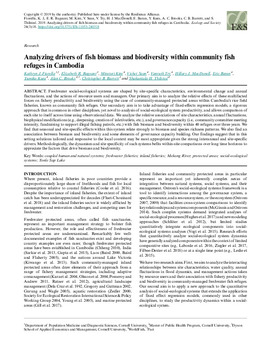Analyzing drivers of fish biomass and biodiversity within community fish refuges in Cambodia

Citation
Fiorella, K. J. et al. (2019). Analyzing drivers of fish biomass and biodiversity within community fish refuges in Cambodia. Ecology and Society 24(3): 18.
Freshwater social-ecological systems are shaped by site-specific characteristics, environmental change and annual fluctuations, and the actions of resource users and managers. Our primary aim is to analyze the relative effects of these multifacted forces on fishery productivity and biodiversity using the case of community-managed protected areas within Cambodia’s rice field fisheries, known as community fish refuges. Our secondary aim is to take advantage of fixed-effects regression models, a rigorous approach that is common in other disciplines, yet novel to analysis of social-ecological system productivity, and allows comparison of each site to itself across time using observational data. We analyze the relative associations of site characteristics, annual fluctuations, biophysical modifications (e.g., deepening, creation of inlet/outlets, etc.), and governance capacity (i.e., community committee meeting intensity, fundraising to support illegal fishing patrols, etc.) with fish biomass and biodiversity within 40 refuges over three years. We find that seasonal and site-specific effects within this system relate strongly to biomass and species richness patterns. We also find an association between biomass and biodiversity and some elements of governance capacity building. Our findings suggest that in this setting solutions tailored and responsive to the local context may be most appropriate given the strong interannual and site-specific drivers. Methodologically, the dynamism and site specificity of such systems befits within-site comparisons over long time horizons to appreciate the factors that drive biomass and biodiversity.
Permalink
Link to PDF
Date Available
Type
Publisher
Countries
Copyright
CC-BY-NC-4.0
Research Themes
Topics
Language